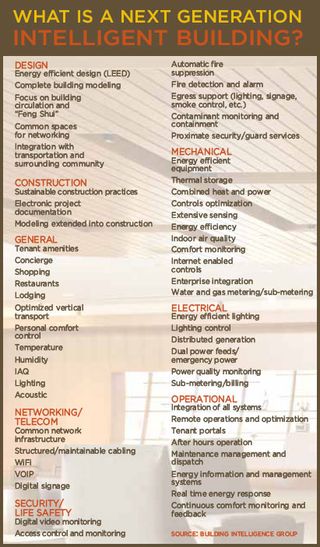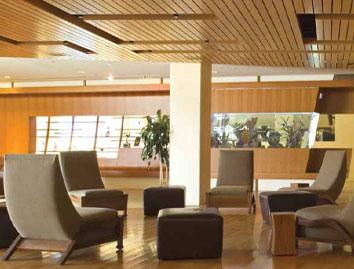At its most basic, an intelligent building is one that applies technologies to improve the building environment and functionality while controlling costs. Intelligent buildings integrate disparate building systems so they can be controlled by a centralized common user interface. As technology evolves, the number of systems that can be integrated into intelligent buildings continues to grow. The most commonly integrated systems are base building related, such as lighting, HVAC, power management, and safety and security. However, amenities such as digital signage, interactive touchscreen directories, broadband services, videoconferencing, voiceover IP, and guest access, in addition to automated business operations such as accounts payable and receivable, are increasingly being added to the infrastructure of intelligent buildings.
"AV systems are very much a part of intelligent buildings," says Ron Zimmer, president and CEO of Ottawa-based Continental Automated Buildings Association (CABA), the not-for-profit industry association that promotes advanced technologies for the automation of homes and buildings in North America. "They are increasingly becoming more important as the building sector moves forward and more technology - not less - is being utilized within the building sector."
However, in 2002 CABA managed the publication of what some consider the definitive report on intelligent buildings, the Technology Roadmap (TRM) for Intelligent Buildings. The report's inclusion of AV systems was limited to technologies that support and increase the efficiency and monitoring of base building operations such as lighting, energy management, and HVAC, and in distributed building control, which allows the use of surveillance and communications devices.
"Intelligence is the ability to use that audio and video to manage the building," says Frank Spitzer, one of the authors of the original TRM and associate director, IBI Group, Toronto, a group of companies practicing professional consulting. "Many offices now have a room that has AV facilities in it, but that doesn't make it an intelligent building."

The largest AV component in intelligent buildings so far has been limited to control rooms in the form of "dashboards" - a graphic user interface (GUI) that allows facilities and maintenance supervisors the ability to monitor and measure building functions. But according to some industry experts, the role of AV in intelligent buildings is on the cusp of change.
"AV is not currently on building automation systems (BAS)," says Brian Brustad, CTS-D, associate with the Special Systems Design Group (SSDG) at RTKL, a Baltimore, MD based design firm. "AV control systems can only monitor the building automation and control network. However, it could be implemented far deeper into the building network. AV is a controllable system that would benefit from an intelligent network."
Aiding the integration of AV into intelligent buildings is that in the last few years many AV devices have gained IP communications capability. "These days AV equipment comes with network jacks and some level of network controllability," says Ed Morman, CTS-D, associate at RTKL. "There are sensor capabilities built into AV control systems - temp sensors, light sensors, occupancy sensors - that could be tied back into a building control system to do things like solar harvesting. There are a number of things that should be done or should be tied in with a building automation system that aren't necessarily done now, but could be."
CONVERGENCE, AGAIN

"This is really not about [whether] to have AV or not to have AV," says Tom Shircliff, who, along with Rob Murchison, is cofounder of Intelligent Buildings Group, Charlotte, NC, a firm that designs, installs, and maintains open standards technology infrastructure in commercial real estate properties. "Most buildings have many forms of it. The challenge is to view all the AV as part of one strategy so as to avoid silos and inefficient or ineffective applications."
In buildings, most people think of AV as videoconference systems, digital signage displays in lobbies, and elevator music, but as AV becomes more integrated, these items will serve multiple purposes, such as security and safety messages, as well as a way to control and monitor other building functions. "There's really a push toward more integration in the conference room and presentation room," says Paul Ehrlich, founder and president, Building Intelligence Group, St. Paul, MN. With a fully integrated system, tenants can control not just the AV equipment, but also the lights, blinds, room temperature, and ventilation from a panel or a console in the room. The room can also be booked from a web-based interface, which may also help the facilities personnel monitor equipment usage, projector bulb life, and equipment security.
"That's the whole point of an intelligent building," Murchison says. "Tenant and building demands are really all, in some way or another, part of the same backbone or the same technology standards."
DOUBLE THE SKILL SETS
Rethinking the functions of the systems also requires rethinking how the systems are installed. Traditionally, the design and construction is done in divisions, or silos, with separate teams for mechanical and electrical that report to the general contractor who answers to the owner or developer. "That is starting to break down," Shircliff says. "How do I work in a silo and plan to converge or work with the other systems? Almost nothing in a building anymore should be done in the traditional style or fashion, and that includes AV."
Specifiers and installers may now be required to know about more than their own system. "We look for people who understand business, technology, and networking, and they need to have a core set of a minimum of two systems," Ehrlich says. Of course, HVAC and lighting controls are the heavyweights of BAS, followed by fire and security and AV. "We see system integrators as being somewhat generalists," he continues. "You've got to have that core understanding of how your customer does their business, of user interface, of networking and technology, and then beyond that you have to be able to work with other contractors that are going to install the other specialized systems."
Contractors can build these different skill sets through attending manufacturer- sponsored seminars as well as by creating alliances through different organizations. The National Systems Contractors Association (NSCA), Cedar Rapids, IA, the leading not-for-profit association representing the commercial electronic systems industry, helps its members forge partnerships with non-competing members, as well as provides information for those that want to branch out. "We're seeing companies that want to stay focused on AV that are creating partnerships and strategic alliances with the building technologies companies," says Chuck Wilson, executive director, NSCA. "We put like-minded companies together.
We're also seeing these integrators diversifying their product line and adding new technology so that they can become a total systems provider. Some companies want it all, others want just a small piece of it."
This type of flexibility is creating expanded opportunities for AV consultants and contractors. "If you're an AV consultant or an AV contractor, you have the opportunity now to be involved outside of where the projectors and the presentation space is," Ehrlich says. "There aren't enough system integrators, so they're going to come from the people that are already connecting traditional systems in an integrated fashion in that conference room or boardroom."
A COMMON LANGUAGE
CABA's TRM report notes that most of the required technologies for intelligent buildings were generally available but not widely adopted. But that didn't take the potential for AV technology into consideration. One barrier to a wider adoption in intelligent buildings is that AV technology itself may not be up to the task.
In 1998, Crestron Electronics, Rockleigh, NJ, began putting Ethernet ports in all of its AV products and control products so that they could be integrated into a package and made part of an intelligent solution. "We've always been known as the 'United Nation' to the electronics world," says Bill Schaffer, director of sales, Crestron. "We take other people's languages and bring them all together. We can make them talk to each other. We act as that bridge and provide the user interface and control to make it all work seamlessly together."
AMX, Richardson, TX, makes similar claims. "The beauty of our control box is that we can talk pretty much any language or protocol you want, so we can interface with most systems," says Robert Noble, chief technology officer, AMX. "Basically, we're kind of an open book, if you will, and we bolted on to several different building management systems out there from an applications level."
But despite these claims, some designers are still encountering obstacles in finding a common language. "You do get integration in that they go to each system independently, but it's not as efficient as it could be," Morman says. "Right now, the AV control integrators are not up to speed. It still requires custom programming."
In intelligent buildings, AV is still a new technology. Despite many protocols that are available and well defined, they're not typically supported by most of the intelligent AV control processors. "That's why AV ends up being a user of data provided from the networks, but not necessarily able to contribute to that data," Brustad says. "Manufacturers have yet to provide the necessary software programming tools and interfaces to easily implement intelligent building communication with these systems. Rather than providing a single communication link to the main building control, they're going to each of these services independently, and that's a huge disadvantage. It's basically bypassing one of the best advantages of building automation, which is the one point of communication between all devices."
To help overcome this challenge, CABA has taken a strong industry stand that the industry needs to move to open standards. "When you have proprietary standards, the end-users will sometimes feel like they're locked into a specific system or products and services provided by a specific company, and if they want to tie it in with other systems, it become an issue," Zimmer says. With open standards, decisions for purchase can be based on the best product for the building's needs, the service that the manufacturer provides, such as warranty and user workshops, as well as price.
"It's something that's frustrating because networked AV has great potential, but it's happening slower and more gradually than anybody would like to see," Ehrlich says. "But that's probably typical of anything that goes on in the construction trades. Nothing happens fast."
Beck Ireland is a freelance writer and editor based in Kansas City, MO. She has more than five years of professional experience as a journalist serving the entertainment technology and electrical construction industries. She can be reached attwitteringmachine@gmail.com.










